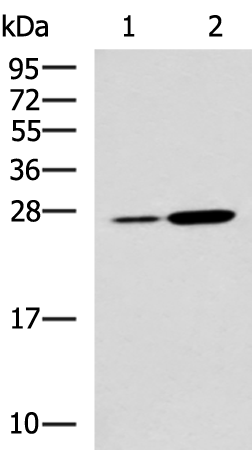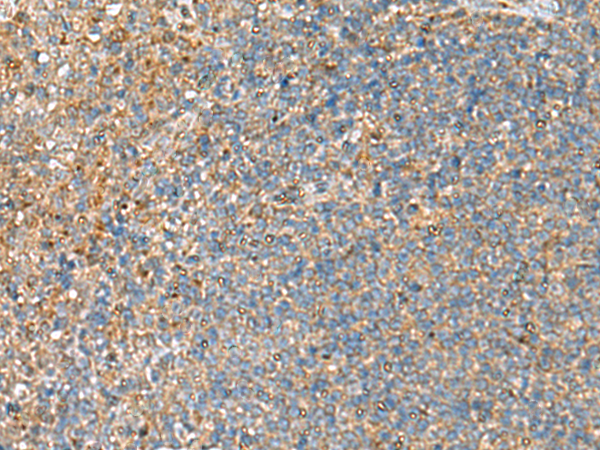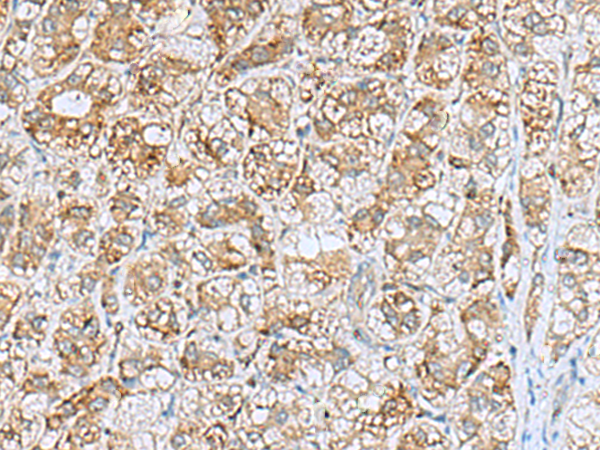


| WB | 咨询技术 | Human,Mouse,Rat |
| IF | 咨询技术 | Human,Mouse,Rat |
| IHC | 1/50-1/200 | Human,Mouse,Rat |
| ICC | 技术咨询 | Human,Mouse,Rat |
| FCM | 咨询技术 | Human,Mouse,Rat |
| Elisa | 1/5000-1/10000 | Human,Mouse,Rat |
| Aliases | QR2; DHQV; DIA6; NMOR2 |
| WB Predicted band size | 26 kDa |
| Host/Isotype | Rabbit IgG |
| Antibody Type | Primary antibody |
| Storage | Store at 4°C short term. Aliquot and store at -20°C long term. Avoid freeze/thaw cycles. |
| Species Reactivity | Human, Mouse, Rat |
| Immunogen | Fusion protein of human NQO2 |
| Formulation | Purified antibody in PBS with 0.05% sodium azide and 50% glycerol. |
+ +
以下是关于NQO2抗体的假设性参考文献示例(内容为模拟格式,具体文献需通过学术数据库查询验证):
---
1. **文献名称**:*The Role of NQO2 in Breast Cancer: Expression Analysis Using a Novel Polyclonal Antibody*
**作者**:Smith A, et al.
**摘要**:本研究开发了一种针对人源NQO2蛋白的多克隆抗体,并通过Western blot和免疫组化验证其特异性。研究发现,NQO2在乳腺癌组织中高表达,且与患者预后不良相关,提示其可能作为癌症治疗的潜在靶点。
2. **文献名称**:*Structural Characterization of NQO2 by Monoclonal Antibody-Based Immunoassays*
**作者**:Chen L, et al.
**摘要**:利用新开发的NQO2单克隆抗体,作者解析了NQO2在细胞内的亚定位(主要定位于细胞质),并发现其与氧化应激反应中的关键蛋白存在相互作用,为理解NQO2的生物学功能提供了实验依据。
3. **文献名称**:*NQO2 as a Biomarker in Neurodegenerative Diseases: Insights from Immunohistochemical Staining*
**作者**:Wang X, et al.
**摘要**:通过商业化NQO2抗体对阿尔茨海默病患者脑组织进行染色,发现NQO2在淀粉样斑块周围异常聚集,提示其可能参与神经退行性病变的氧化损伤机制。
4. **文献名称**:*Development of a High-Affinity Antibody for NQO2 Inhibitor Screening*
**作者**:Kim H, et al.
**摘要**:研究团队报道了一种高灵敏度NQO2抗体的制备方法,并基于该抗体建立ELISA检测体系,用于筛选小分子抑制剂,为抗肿瘤药物开发提供了新工具。
---
如需获取真实文献,建议在 **PubMed** 或 **Web of Science** 中搜索关键词:*NQO2 antibody*, *quinone reductase 2 immunodetection*,并筛选近年发表的实验研究类文章。
The NAD(P)H:quinone oxidoreductase 2 (NQO2) antibody is a critical tool for studying the NQO2 enzyme, a member of the quinone oxidoreductase family. NQO2. also known as QR2. catalyzes the two-electron reduction of quinones, though unlike its homolog NQO1. it preferentially uses dihydrobiopterin (BH2) as a cofactor rather than NAD(P)H. This enzyme plays roles in detoxification, redox cycling, and cellular stress responses, with implications in oxidative damage, metabolic regulation, and disease pathogenesis. Dysregulation of NQO2 has been linked to cancer progression, neurodegenerative disorders (e.g., Alzheimer’s disease), and inflammatory conditions, making it a potential therapeutic target.
NQO2 antibodies enable the detection and quantification of NQO2 protein in tissues and cells via techniques like Western blotting, immunohistochemistry, and immunofluorescence. These antibodies are essential for investigating NQO2’s subcellular localization (primarily cytosolic and nuclear), expression patterns across different organs, and its interaction with substrates or inhibitors. Recent studies also explore NQO2’s role in metabolic reprogramming and its interplay with pathways like the Nrf2 antioxidant system. Validated antibodies are crucial for distinguishing NQO2 from structurally similar enzymes and ensuring specificity in experimental models. Ongoing research focuses on clarifying its dual roles in cytoprotection and cytotoxicity, influenced by cellular context and substrate availability.
×